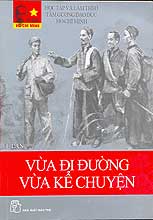 The Ho Chi Minh Museum is compiling a file on Vua Di Duong Vua Ke Chuyen (Telling a Story While Traveling), which the president first penned under the name T Lan while on his way to country’s northeast to direct the Bien Gioi (border) campaign against the French troops in 1950.
The Ho Chi Minh Museum is compiling a file on Vua Di Duong Vua Ke Chuyen (Telling a Story While Traveling), which the president first penned under the name T Lan while on his way to country’s northeast to direct the Bien Gioi (border) campaign against the French troops in 1950.Museum’s director Chu Duc Tinh said considering the criteria for documentary heritage under the UNESCO’s World Memory programme, staffs were confident a proposal would be recognised.
The compilers aim to receive recognition in time for the president’s 120th birthday in May, 2010.
The narration reviewed important events during the president’s more than 30 years of revolutionary work from when he left the country for France in 1911 until the success of the August Revolution against French rule in 1945.
Much of the typed script, which has been carefully edited by researchers, covers President Ho’s working style and his thrift such as his use of the blank sides of printed sheets and the back of pages torn from calendars for writing.
The work was considered more than literary value because it covered historical events. With its high degree of accuracy, it was reliable material for research on President Ho’s revolutionary work, compilers said.
Pham Sanh Chau head of External Culture and UNESCO Department of the Ministry of Foreign Affairs, said the script’s uniqueness made it eligible for consideration.
The work, first published in Nhan Dan (People) Newspaper in 1961, was printed as a book in 1963 and has since been reproduced many times.
The original script was stored in the Presidential Palace from 1961-69 before being transferred to the museum.
Mr. Tinh said the carefully compiled file had precise details of various values and the inspiration it gave future generations.
The file would also highlight the work’s international significance as required by the criteria for nomination as a World Memory’s Documentary Heritage title.
Mr. Tinh said the museum would invite specialists to help complete the file. Compilers aim to submit their final file within a month to the Ministry of Culture, Sports and Tourism.
The file, completed with support from the Ministry of Foreign Affairs and National Archives Department, would then be sent to the Government for approval.